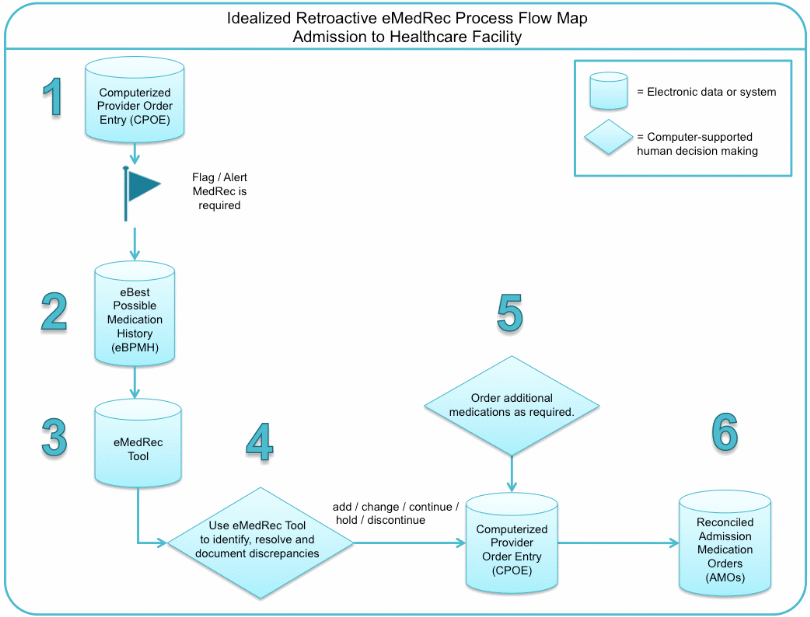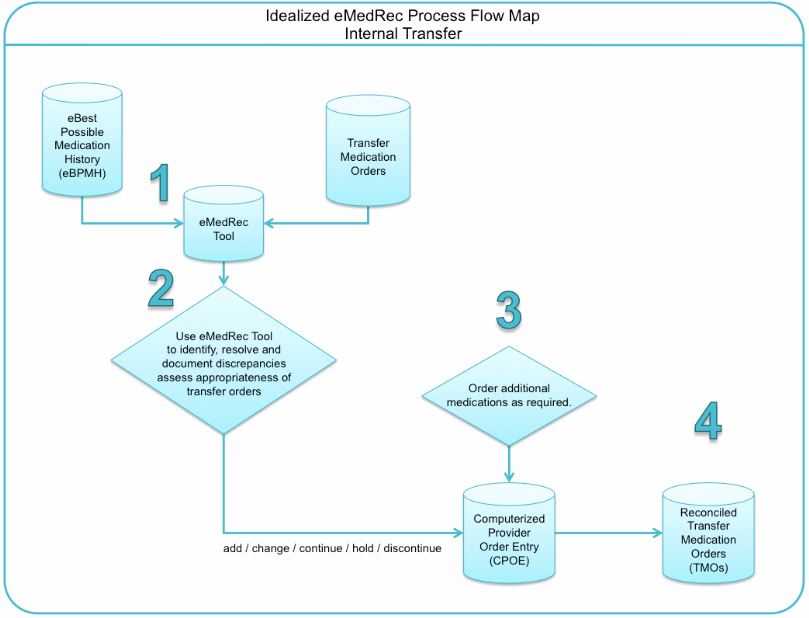The avoidance of medication error is vital to quality care and safety of the patients. Medical error denotes an avoidable, undesirable result of healthcare, whether apparent, concealed, harmful, or harmless to the patient. A medical error may entail a wrong or imperfect diagnosis or prescription of illness, parturition, syndrome, contagion, or any other disorder. A medication error arises when a medical practitioner selects an unsuitable means of care or wrongly implements a suitable process of care; in healthcare, medical errors are usually expressed as human inaccuracies (Petronio, Helft, & Child, 2013).
Nevertheless, the definition of medical error has been under debate since numerous kinds of medication errors that range from insignificant to far-reaching exist, and causality is frequently poorly verified. This research project will discuss improvement of medication reconciliation practices aimed at ensuring patient safety. All medical professionals and health institutions should strive to reduce the occurrence of medical errors and ensure that they effectively identify their causes, set up resolutions, and gauge the triumph of improvement.
Literature Review
Medication errors symbolize stern public health care concerns and create a threat to the wellbeing of patients (Petronio et al., 2013). Medical errors are leading causes of death in the United Sates since between 45000 and 99000 patients are believed to die every year due to medication errors (Andel, Davidow, Hollander, & Moreno, 2012). Medication errors are accounted to cost the United States between $18 billion and $30 billion every year in lost revenue, disability, reduced productivity, and further medical costs (Andel et al., 2012).
On this note, there is a need to support correct assessments of the occurrence of medical errors as a fundamental prerequisite for their avoidance. As medical institutions ascertain “error” as a medical and study precedence, the resolution of possibly the vital inquiry remains elusive: What can be done to reduce medical errors and ensure prevention of their occurrence, anchored in vivid and consistent definitions and crucial requirements for successful action? Institutional and systems management, quality enhancement, patient safety, interpreting and incorporating research into practice, collaboration, and prevention of medication errors are crucial for boosting patient care (Ignjatović-Ristić, Vasiljević, Rančić, & Ristić, 2014).
According to the quantitative survey by Hripcsak, Sengupta, Wilcox, and Green (2007), health departments, especially the emergency unit, signify a considerable shift of care for patients and the comprehension of the longitudinal patient health situation (for instance, allergies, medicines, challenges, diagnoses, previous procedures, and pending tests) is vital to the formulation of a suitable strategy for care. Since most visits to the emergency departments are impromptu and urgent, the health conditions of the patients might not be issued beforehand to the caregivers.
Even in cases that the information is availed to the caregiver, time constraints may limit their ability to pursue it (Hripcsak et al., 2007). Such information gaps could result in not just poor quality of care, but also inefficiencies in care, in the nature of redundant tests, care impediments, medication errors, and less successful treatments stipulated instead of more modified interventions as a preventative measure when vital information is not accessible. Improvements in the healthcare sector could result in positive effects not only on the patients but also the health professionals in the respective organizations (Carayon et al., 2014).


The objective of Hripcsak et al. (2007) was to examine the manner in which medical data from earlier visits is presented by the longitudinal electronic patient record and applied in the emergency department. The authors employed comprehensive user inspection logs to gauge access to dissimilar forms of data. A longitudinal electronic patient record was found mostly applicable in the diagnosis by the health professionals and provision of radiology and laboratory data, which proved valuable in most occurrences (common forms of details were utilized in 5 to 20 percent of the instances).
Information was accessed in less than half of the incidences (from 20 to 50 percent of the situations) even in occurrences that the user was informed of the existence of data (Hripcsak et al., 2007). The degree of access demonstrates that the medical information exchange programs ought to be conservative in approximating how regularly shared information will be employed. Moreover, the broad range of the accessed data signifies that though a medical summary has the potential of being valuable, a perfect solution will necessitate offering a wide scope of information and advocating for its use by health professionals in an effort of avoiding medication errors and ensuring quality care and patient safety (Raban & Westbrook, 2014).
Methodology
Research Design
This study will exploit the primary means of data collection where information will be acquired from Tisch Hospital, in New York City. The type of research design that will be employed in this project is qualitative study. Qualitative analysis, mainly ethnographic research, will assist in gathering an extensive narrative data. An interview will be conducted with a suitable number of participants to ensure a thorough grasp of the phenomena behind the study.
Population and Sample
The population for this study will be the health professionals and patients in Tisch Hospital. A written application for the selection of the participants for the interview will first be made to the Chief of Hospital Operations. At the start, the concerns regarding the study will be discussed through conversations with the personnel of the hospital prior to proceeding to interview different patients. Such discussions will also be carried out with specialists at the institution.
Sampling Strategy
The non-random sampling strategy that will be employed in this research project is convenience sampling since it will just involve the most accessible and easily selected participants to undertake the set interview. The means of connecting with the most pertinent participants will be reached following talks with the Chief of Hospital Operations after which he will then send them (about five doctors, eight male patients, and seven female patients) requests to take part in the study, which will ensure utmost confidentiality. Twenty requests will be issued and will constitute the expected final sample for the interview.
Data Collection Plan
Subsequent to the selection of the participants, open-ended interview questions will be presented since they will play a pivotal role in bringing out answers that the researcher could not have predicted and are usually lengthier with a clarification of the occurrence of interest in an accurate and concise design. On this note, the interviewees will have the capacity of responding to the inquiries in an assay format thereby offering room for adequate details without any constraint. The survey manner of collecting the data for this research project will be successful since fundamental concerns on the most successful practices that may be employed for enhancing medication safety across every point of transitional care will be discussed.
Instrumentation
Before allowing every interviewee to start tackling the interview questions, the interviewer will illuminate every bit of the process, clarify the rationale for the study, give a clue in the form of questions to anticipate, affirm the strict discretion with which all the given information will be treated, and highlight the autonomy of participation. After this is achieved, the researcher will give the participants a go ahead. The questionnaire will have five main questions. The time for the interview will be approximately 30 minutes. The interviewees will also be notified of the use of a tape recorder for the improvement of the correctness of the information gathered and the development of a permanent record. The details held in the tape recorder will later be transcribed to ascertain steady information for reference when essential.
Data Analysis
The data analysis approach for this research project will depend on the study technique and form of data collected. For this study, a qualitative means of data analysis will be employed. The assessment of the nominal facts for this study will be descriptive and will have a vital task in backing a better understanding of the intricacy of the present medication management practices in addition to characteristic organizational flaws resulting in the incidence of errors.
Conclusion
The rising insight of the incidence, causes, and effects of medical error strengthen the necessity to boost the comprehension of the problem and create practical resolutions and prevention policies. This research project will be influential in the creation of a program for the incorporation of appropriate medication reconciliation practices into all relevant medical processes, and handling execution challenges to ensure patient safety, quality care, and positive outcomes.
References
Andel, C., Davidow, S. L., Hollander, M., & Moreno, D. A. (2012). The economics of health care quality and medical errors. Journal of Health Care Finance, 39(1), 39-50.
Carayon, P., Wetterneck, T. B., Rivera-Rodriguez, A. J., Hundt, A. S., Hoonakker, P., Holden, R., & Gurses, A. P. (2014). Human factors systems approach to healthcare quality and patient safety. Applied Ergonomics, 45(1), 14-25.
Hripcsak, G., Sengupta, S., Wilcox, A., & Green, R. A. (2007). Emergency department access to a longitudinal medical record. Journal of the American Medical Informatics Association, 14(2), 235-238.
Ignjatović-Ristić, D., Vasiljević, S., Rančić, N., & Ristić, B. (2014). Difficulties in proving medical errors: Where do we stand? Vojnosanitetski Pregled, 71(4), 390-394.
Petronio, S., Helft, P. R., & Child, J. T. (2013). A case of error disclosure: A communication privacy management analysis. Journal of Public Health Research, 2(3), 175-181.
Raban, M. Z., & Westbrook, J. I. (2014). Are interventions to reduce interruptions and errors during medication administration effective? A systematic review. BMJ Quality & Safety, 23(5), 414-421.
The Electronic Medication Reconciliation Group. (2017). Paper to electronic MedRec implementation toolkit (2nd ed.)